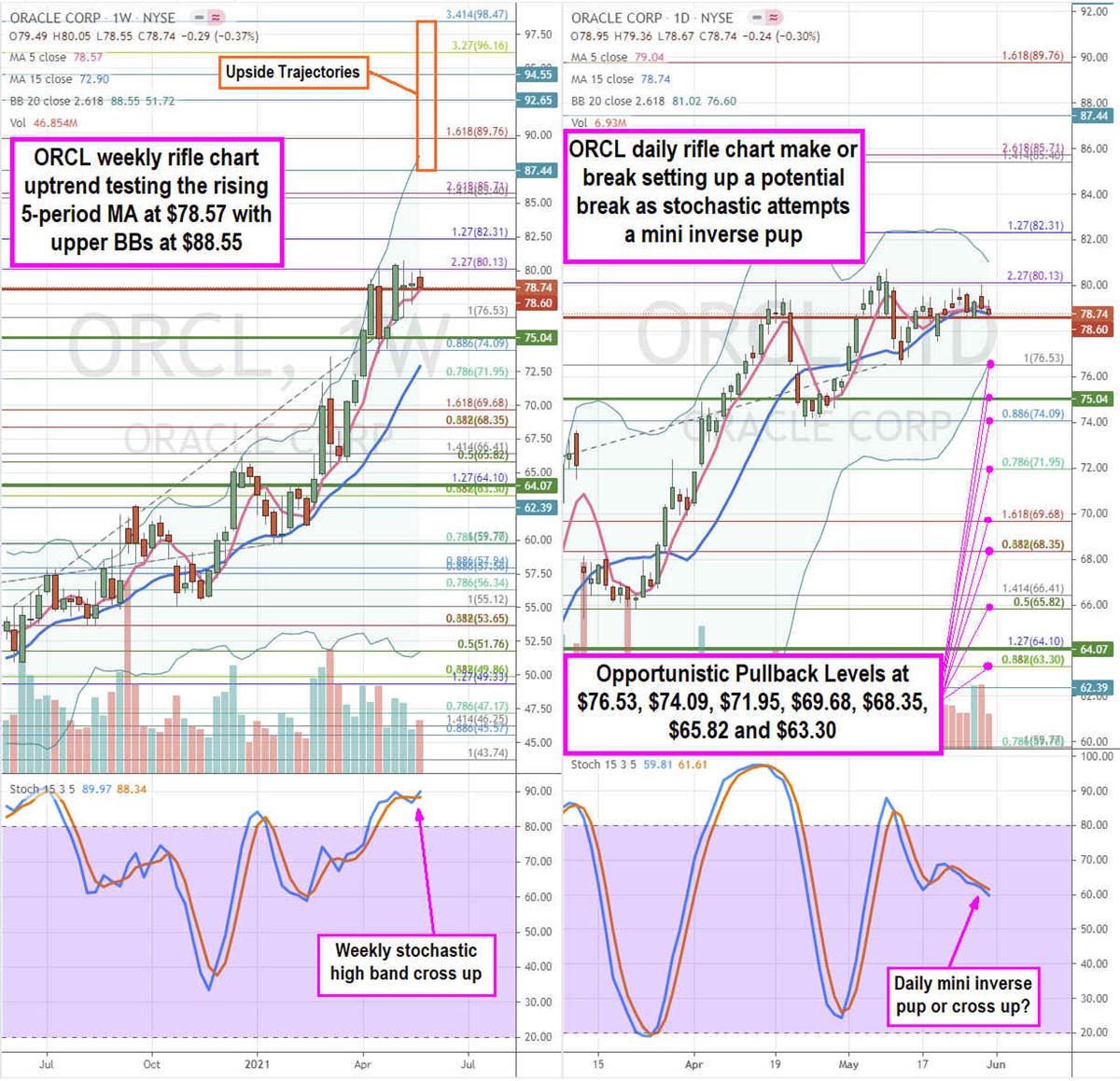Oracle Stock is Ready to Surge Higher Enterprise information technology provider Oracle Corporation (NASDAQ: ORCL) stock has been steadily grinding to all-time highs as post-pandemic growth resumes.
By Jea Yu
This story originally appeared on MarketBeat

Enterprise information technology provider Oracle Corporation (NASDAQ: ORCL) stock has been steadily grinding to all-time highs as post-pandemic growth resumes. As workers return to offices and the reopening gets underway with the acceleration of COVID vaccinations, Oracle shares have been climbing in anticipation of the growth spurt. The Company has indicated impressive growth metrics in its recent earnings report granted the pandemic set the bar low for 2020 comps. While pundits argue that Oracle's migration to cloud has been slow, the database giant is reaping the rewards of its acquisitions and investments. Shares still trade at a modest forward P/E of 17 with over $37 billion in cash. The Company is leading the enterprise-resource-planning (ERP) battle against rival SAP (NYSE: SAP) according to its eccentric co-founder Larry Ellison. Prudent investors seeking exposure in the enterprise software segment as the reopening takes shape can monitor for opportunistic pullback levels in Oracle shares.
Fiscal Q3 2021 Earnings Release
On March 10, 2021, Oracle released its fiscal third-quarter 2021 results for the quarter ended February 2021. The Company reported an earnings-per-share (EPS) profit of $1.16 versus $1.11 consensus analyst estimates, a $0.05 beat. Revenues grew 3% year-over-year (YoY) to $10.09 billion, beating analyst estimates for $10.07 billion. Cloud service and license support revenues rose 5% to $7.3 billion. Cloud license and on-premise license revenues rose 4% to $1.3 billion. Non-GAAP operating income rose 10% YoY to $4.8 billion and non-GAAP operating margin was 47%. Oracle Gen2 Cloud Infrastructure revenues rose 100%. The Company increased the quarterly dividend to $0.32 from $0.24 per-share. The share buyback program was increased by $20 billion. Oracle CEO Safra Catz stated, "We continued to extend our huge lead in the cloud ERP market as Fusion ERP grew 30% and NetSuite ERP grew 23% in Q3. Oracle's rapidly growing highly-profitable, multi-billion dollar cloud ERP businesses helped drive subscription revenue up 5% and operating income up 10% for the quarter. Subscription revenue now accounts for over 72% of Oracle's total revenues, and this highly predictable recurring revenue stream along with expense discipline are enabling double-digit increases in non-GAAP earnings per share."
Raising Fiscal Q4 2021 Guidance
Oracle raised Q4 fiscal 2021 EPS estimates to $1.28 to $1.32 versus $1.27 consensus analyst estimates. Revenues are expected to grow 5% to 7%.
Conference Call Takeaways
CEO Catz pointed out, "As I mentioned last quarter, we experience capacity constraints for OCI cloud services as customer workloads expanded dramatically. In addition, we continue to land many new customers, including ISVs, and we have some very large users coming online shortly that will require significant amounts of capacity." The Company is investing "aggressively" to accommodate the increased cloud consumption expected for FY2022. Oracle expects 49% operating margin for Q4.
Burying SAP
The eccentric Oracle co-founder Larry Ellison chimed in during the conference call to call out competitor SAP CFO, Luka Mucic's statement about not losing a single ERP customer to Oracle, "In other words, after personally checking, SAP's Chief Financial Officer could not find a single example of an SAP ERP customer move into Oracle Fusion on ERP, not one. Perhaps he should have check more carefully." Ellison gloated, "In Q3 alone we signed contracts, totaling hundreds of million of dollars to migrate several very large SAP ERP customers, to Oracle Fusion ERP. But this was not just a recent Q3 event. This has been going on for year. I'm now going to go and present a list of over 100 companies and government agencies that have already moved from SAP ERP to Fusion ERP, or currently in the process of doing so." Ellison proceeded to run through the list to underscore his point of discrediting SAP. After the exhaustive ramble, Ellison concluded, "I am going to stop right there, or I'll take up all of the time you won't be able to ask Safra questions. Okay. I don't want to do that. Okay. All right. So again, the list is actually longer than 100-plus companies. I did read over 100 companies and I'm sure you're painfully aware of. List is actually longer than 100 companies I have just read." This underscores Ellison's famous Genghis Khan quote, "It's not enough that I win, others must fail." He made the exhaustive (and almost comical) point that SAP has failed when up against Oracle's ERP, pointing out that SAP is not even number two but barely number three as per Gartner.

ORCL Opportunistic Pullback Levels
Using the rifle charts on the weekly and daily time frames provides a precision view of the landscape for ORCL stock. The weekly rifle chart uptrend has a rising 5-period moving average (MA) support testing at $78.57 with upper Bollinger Bands (BBs) at $88.55. Shares have a strong resistance at the $80.13 Fibonacci (fib) level. The weekly market structure low (MSL) triggered on the breakout through $64.07 followed by a daily MSL trigger on the $75.04 breakout. The daily market structure high (MSH) sell triggers below $78.60. The daily rifle chart is slowing down as the BBs compress and the 5-period and 15-period MAs go flat. The daily stochastic is starting to form a mini inverse pup but is still in a make or break. The daily make or break will resolve itself in a breakout or a breakdown. Prudent investors can monitor for opportunistic pullback levels at the $76.53 fib, $74.09 fib, $71.95 fib, $69.68 fib $68.35 fib, $65.82 fib, and the $63.30 fib. Upside trajectories range from the $87.44 level up to the $98.47 fib.
Featured Article: What is Put Option Volume?









